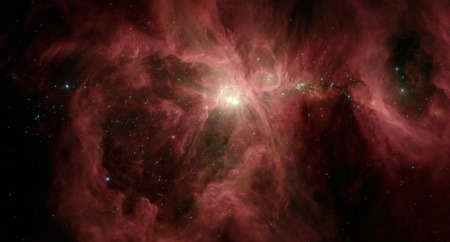Orion in the Infrared

Creator: Spitzer Space Telescope, Pasadena, CA, USA
Image Source: http://www.spitzer.caltech.edu/images/1645-ssc2006-16a1-Orion-in-the-Infrared
This infrared image from NASA's Spitzer Space Telescope shows the Orion nebula, our closest massive star-making factory, 1,450 light-years from Earth. The nebula is close enough to appear to the naked eye as a fuzzy star in the sword of the popular hunter constellation.
The nebula itself is located on the lower half of the image, surrounded by a ring of dust. It formed in a cold cloud of gas and dust and contains about 1,000 young stars. These stars illuminate the cloud, creating the beautiful nebulosity, or swirls of material, seen here in infrared.
This image shows infrared light captured by Spitzer's infrared array camera. Light with wavelengths of 8 and 5.8 microns (red and orange) comes mainly from dust that has been heated by starlight. Light of 4.5 microns (green) shows hot gas and dust; and light of 3.6 microns (blue) is from starlight.
Above the Orion nebula, where the massive stars have not yet ejected much of the obscuring dust, the infrared view penetrates the dark lanes of dust, revealing bright swirling clouds and numerous developing stars that have shot out jets of gas (green). This is because infrared light can travel through dust.The infrared image shows light captured by Spitzer's infrared array camera. Light with wavelengths of 8 and 5.8 microns (red and orange) comes mainly from dust that has been heated by starlight. Light of 4.5 microns (green) shows hot gas and dust; and light of 3.6 microns (blue) is from starlight.
Image Use Policy: http://www.spitzer.caltech.edu/info/18-Image-Use-Policy
View Options
Image Details
- Image Type
- Observation
- Object Name
- Orion Nebula • Messier 42 • M42 • NGC 1976
- Subject - Milky Way
- Nebula » Type » Star Formation
Position Details

- Position (ICRS)
- RA = 5h 35m 16.3s
- DEC = -6° 0’ 51.2”
- Orientation
- North is 90.0° CW
- Field of View
- 1.4 x 0.8 degrees
- Constellation
- Orion
Color Mapping
| Telescope | Spectral Band | Wavelength | |
|---|---|---|---|

|
Spitzer (IRAC) | Infrared (Near-IR) | 3.6 µm |

|
Spitzer (IRAC) | Infrared (Near-IR) | 4.5 µm |

|
Spitzer (IRAC) | Infrared (Mid-IR) | 5.8 µm |

|
Spitzer (IRAC) | Infrared (Mid-IR) | 8.0 µm |







